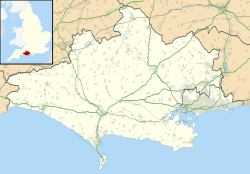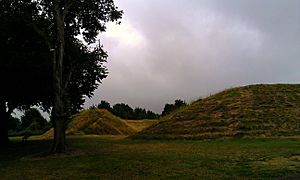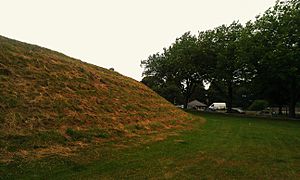Maumbury Rings facts for kids

Interior of Maumbury Rings viewed from southern end
|
|
| Location | Dorchester, Dorset |
|---|---|
| Coordinates | 50°42′28″N 2°26′25″W / 50.70790°N 2.44039°W |
| Type | Henge |
| History | |
| Periods | Neolithic, with later Roman and Civil War modifications |
| Site notes | |
| Public access | Yes |
| Official name | Henge, Romano-British amphitheatre and Civil War fieldworks known collectively as Maumbury Rings |
| Designated | 1 October 1962 |
| Reference no. | 1003204 |
Maumbury Rings is an ancient circular earthwork located in Dorchester, England. It is a large, round area of land with a raised bank around it. This special place has been used for many different things over thousands of years.
First, it was built as a Neolithic henge, which is a type of ancient monument. Later, during the Roman period, it was changed into an amphitheatre for public shows. Even later, during the English Civil War, it became a fort to protect Dorchester. Today, Maumbury Rings is a public park. People use it for outdoor concerts, festivals, and historical re-enactments.
Contents
What is Maumbury Rings?
Maumbury Rings is a large, nearly circular henge. It is found close to the center of Dorchester. The inside of the circle is about 50 meters across. The earth bank around it is about 4 meters wide. It stands about 5.6 meters high on the inside and 4.0 meters high on the outside.
You can see a small bump on the southwest side of the earthwork. This marks where a gun platform was built during the English Civil War. The inside of the bank was also flattened into terraces on the east and west sides at that time. There is no sign of the original ditch that would have been inside the henge.
History of Maumbury Rings
Maumbury Rings has a long and interesting history. It has changed many times over thousands of years.
The Neolithic Period: An Ancient Henge
Archaeologists, like Harold St George Gray, dug at Maumbury Rings from 1908 to 1913. Their digs showed that the site was first built in the later Neolithic period. This was a time when people were starting to farm and build large monuments.
The archaeologists found an inner ditch made of deep shafts dug into the chalk ground. There were up to 45 of these shafts, some as deep as 11 meters. They found things like deer antlers, animal and human bones, flint tools, and carved chalk shapes inside these pits. These findings give us clues about the people who built the henge.
A piece of Grooved ware pottery was found in one pit. A later piece of Beaker pottery was found in another. The henge had one main entrance on its northeast side. People also say a large stone was found west of the entrance in 1849, but it was reburied and has not been seen since.
Other ancient sites are nearby. About 2 kilometers east, you can find traces of a larger henge called Mount Pleasant henge. Another Neolithic area, Flagstones, was also found nearby. In the 1980s, archaeologists found large timber postholes in Dorchester. These suggest there was a huge Neolithic enclosure, about 300 to 400 meters wide, in that area. You can still see red marks in the Waitrose car park that show where some of these timber posts once stood.
The Roman Era: A Grand Amphitheatre
Maumbury Rings was changed a lot during the Roman period. The Romans turned it into an amphitheatre. This was a place where the people of Durnovaria (which is now Dorchester) could watch public shows and events.
The Romans lowered the banks of the henge by about 3 meters. They used this extra earth to make the banks higher. They also dug out the inside to create a flat, oval arena floor. Seating areas were carved into the banks, likely covered with chalk or wood. Small rooms were also dug into the bank on the southwest side and near the center.
During the digs, archaeologists found Roman pottery, coins, and even a burial from the 2nd century. The amphitheatre might have stopped being used by the mid-2nd century. However, some items found suggest there was still activity there in the 4th century.
The Civil War: A Fort for Protection
Between 1642 and 1643, Maumbury Rings was changed again. This time, it was because of the English Civil War. Supporters of Parliament, known as Roundheads, used the site as an artillery fort. They wanted to protect the southern entrance to Dorchester.
To do this, they built a platform for guns and a ramp on the southwest side. They also built the internal terrace. An unfinished well was found near the northwest edge of the arena. Many lead pistol bullets were found on the east bank. These items, along with a ditch outside the northern bank, all date back to the Civil War.
Later Uses and Today
Maumbury Rings was briefly used as an amphitheatre again in the late 1600s and early 1700s. It became a place for public executions. In 1685, after the Monmouth Rebellion, a judge ordered many rebels to be put to death here. In 1705, a young woman named Mary Channing was also executed at the Rings. The famous writer Thomas Hardy wrote about this event in his poem The Mock Wife and mentioned it in his 1886 novel The Mayor of Casterbridge.
By the late 1700s, the area was being used as farmland. In 1846, the path for a new railway line was changed to make sure it did not damage the Rings.
Today, Maumbury Rings is a public park. It is a popular spot for outdoor concerts, festivals, and historical re-enactments. Many of the items found during the archaeological digs are now on display at the Dorset Museum.
Images for kids





